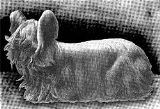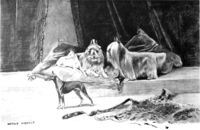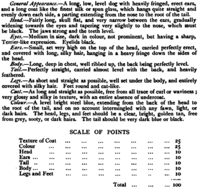
Paisley Terrier
Encyclopedia
The Paisley Terrier was a breed
Dog breed
Dog breeds are groups of closely related and visibly similar domestic dogs, which are all of the subspecies Canis lupus familiaris, having characteristic traits that are selected and maintained by humans, bred from a known foundation stock....
of terrier
Terrier
A terrier is a dog of any one of many breeds or landraces of terrier type, which are typically small, wiry, very active and fearless dogs. Terrier breeds vary greatly in size from just a couple of pounds to over 70 pounds and are usually categorized by size or function...
type
Dog type
Dog types are broad categories of dogs based on function, with dogs identified primarily by specific function or style of work rather than by lineage or appearance....
dog
Dog
The domestic dog is a domesticated form of the gray wolf, a member of the Canidae family of the order Carnivora. The term is used for both feral and pet varieties. The dog may have been the first animal to be domesticated, and has been the most widely kept working, hunting, and companion animal in...
from Great Britain
Great Britain
Great Britain or Britain is an island situated to the northwest of Continental Europe. It is the ninth largest island in the world, and the largest European island, as well as the largest of the British Isles...
. The breed is now extinct. The Paisley Terrier was bred primarily as a pet and showdog version of the Skye Terrier
Skye Terrier
The Skye Terrier is a breed of dog that is a long, low, hardy terrier.-Coat:The Skye is double coated, with a short, soft undercoat and a hard, straight topcoat. The ideal coat length is 5 inches , with no extra credit for a longer coat. The shorter hair of the head veils the forehead and...
, and was the progenitor of today's Yorkshire Terrier
Yorkshire Terrier
The Yorkshire Terrier is a small dog breed of terrier type, developed in the 19th century in the county of Yorkshire, England to catch rats in clothing mills. The defining features of the breed are its size, to , and its silky blue and tan coat...
. The breed was called the Paisley
Paisley
Paisley is the largest town in the historic county of Renfrewshire in the west central Lowlands of Scotland and serves as the administrative centre for the Renfrewshire council area...
terrier since most of the dogs came from that location, but it was also called the Clydesdale
Clydesdale
Clydesdale was formerly one of nineteen local government districts in the Strathclyde region of Scotland.The district was formed by the Local Government Act 1973 from part of the former county of Lanarkshire: namely the burghs of Biggar and Lanark and the First, Second and Third Districts...
Terrier, for another location in the Clyde Valley where the dogs were bred.
Appearance

Coat (dog)
The coat of the domestic dog refers to the hair that covers its body. A dog's coat may be a double coat, made up of a soft undercoat and a coarser topcoat, or a single coat, which lacks an undercoat...
) of blue and tan, and was shown along with the hard-coated Skye Terriers. They were further described as having a great profusion of silky fur with very profuse ear feathering (long hair on the ears.) To differentiate it from the Skye, it was nicknamed the Silky. From the earliest time of the breed, the beauty of the coat won prizes at dog shows. Traditionally, the dogs were shown standing on a box, so that the length of the silky coat could be shown to its best advantage.
The Paisley Terrier was described in 1894 as "an excellent house dog, and most suitable for a lady who wishes something more substantial than a toy", but the care requirements for the coat made it less desirable than some other popular breeds as a pet.
History

Describing the Paisley Terrier in 1894, Rawdon Lee writes that "Though he can kill rats, and maybe other vermin, the Paisley Terrier is essentially a pet dog, and is usually kept as such." The breed was primarily a pet, and it was also a popular showdog. In 1903, the breed is referred to as "a fancier's dog, a sport from the Skye Terrier stock" and despite some fanciers of the time claiming that the breed had the "hardiness and fitness for terrier work
Working terrier
A working terrier is a small type of dog which pursues its quarry into the earth. According to the Oxford English Dictionary, the name dates back to at least 1440, derived from early modern French terrier - from the medieval Latin terrarius from the Latin terra .With the growth of popularity of...
... it is evident that a dog with a coat that looks like silk is simply a toy." Owners and breeders in the 1800s placed a high value on the beautiful blue and tan coat, and would cover the dog's feet and tie the hair back over their eyes to keep the coat looking at its best for dog shows.
The Kennel Club recognised the Paisley Terrier in 1888 as a variety of the Skye Terrier, even though separate show classes had been held for the two types in 1887. However, there were so few entries that the Kennel Club did not continue to encourage offering the category at further exhibitions.
The breed's success as a showdog may have led to its decline. Judges would give awards to the dogs with the long, attractive coat, since length of coat was a principal factor in Skye Terriers. The Paisleys, bred for long but soft coats (useless for a working dog
Working dog
A working dog refers to a canine working animal, i.e., a type of dog that is not merely a pet but learns and performs tasks to assist and/or entertain its human companions, or a breed of such origin...
), would win the prizes. Skye Terrier fanciers objected to the type being shown with Skyes, since they considered the Paisleys to be mixed breeds or possibly crossed with Dandie Dinmonts. The interest of fanciers declined and breed began to disappear.
A book published in 1918 describes Paisley Terriers as uncommon and "I doubt that you'll ever see one in the United States." But with the availability of internet based dog registries that will register breeds with little or no documentation, combined with the public's appetite for unique or "rare
Rare breed (dog)
Rare breed is any breed of dog that is small in number. Since dogs have greater genetic variability than other domesticated animals the number of possible breeds is vast...
" pets, it is likely that there will be attempts to reconstitute the breed.
Continuing influence
The famous 1860s showdog Huddersfield BenHuddersfield Ben
Huddersfield Ben , an early Yorkshire Terrier, is universally acknowledged to be the foundation sire of the breed. In his day Ben won many prizes, both as a show dog and in ratting contests. He was even said to have been hunted...
came from Paisley Terrier stock in the 1860s, and is considered by all authorities to be the founding sire of the Yorkshire Terrier breed, although the Yorkshire Terrier was not recognised as a separate breed until 1898. When the Paisley Terrier went into decline, the smaller and more popular Yorkshire variety superseded it. Through the Yorkshire, the Paisley Terrier is also the ancestor of several other modern breeds, notably the Australian Silky Terrier
Australian Silky Terrier
The Australian Silky Terrier is a small breed of dog of the terrier dog type. The breed was developed in Australia, although the ancestral types and breeds were from Great Britain. It is closely related to the Australian Terrier and the Yorkshire Terrier...
and the Biewer Terrier.

